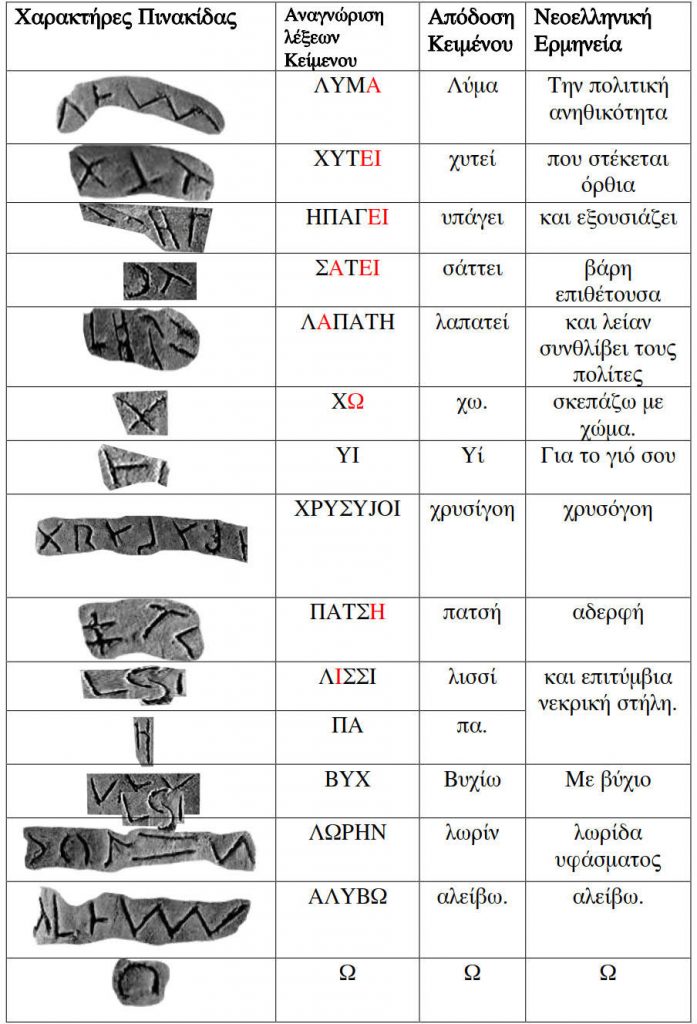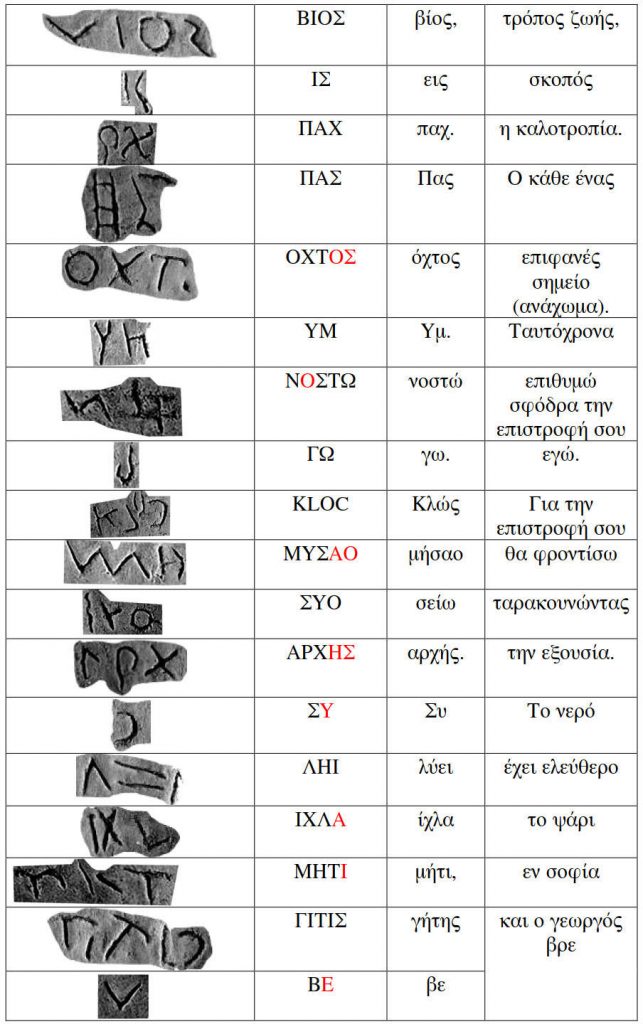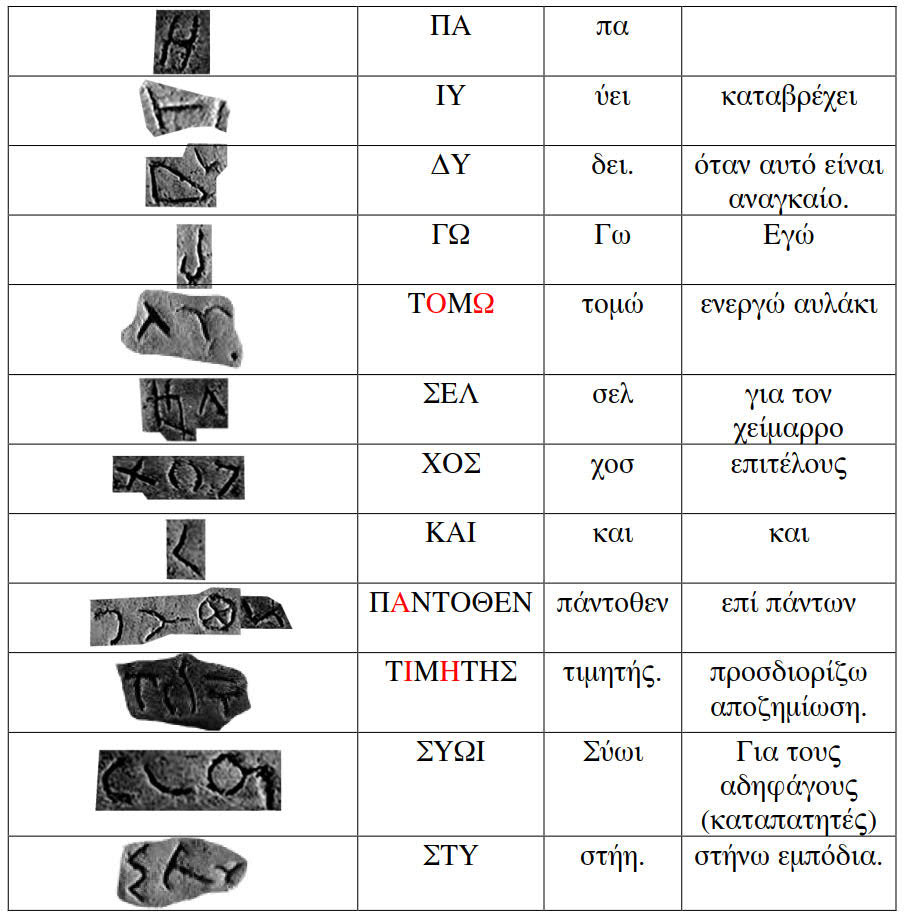GLOZEL SLATE-BOURBONNE
A Praise for a Hero
Α Revolution against the status quo
In 1924, in a field in Glozel, France, some ceramic slates were found. The scientists who dealt with these findings disagree about the time these were inscribed, as well as about their authenticity. Some scientists believe that they belong to the Magdalenian Era (13.000 to 9.000 B.C.), while some others attribute them as findings of the year 1.000 B.C..
Τhe Sepulchral Stele of the Dead People’s Field
Glozel-Vichy-Bourbonne-FRANCE
History
In 1924, in a field in Glozel, France, some ceramic slates were found. The scientists who dealt with these findings disagree about the time these were inscribed, as well as about their authenticity. Some scientists believe that they belong to the Magdalenian Era (13.000 to 9.000 B.C.), while some others attribute them as findings of the year 1.000 B.C..
One of these slates, is the dead person’s Sepulchral Stele, which, as a complete study, was delivered to the former Technological Educational Institute of Western Macedonia by the Director of the Academy, Mr. Ioannis Chamizidis in March 2019, in the Institutionalised Laboratory of Environmental Technology, in order to be translated in French and published, for the first time in the Academic Community of the whole world.
This slate documents social struggles, their results and an oath of honour to keep on struggling, until the final result.
There were judicial decisions that were judged to be fake, as well as their inventors’ fabrications.
The evaluation made by the Director of the International Academy of Ancestral Discourse, Mr. Ioannis Chamizidis, is that, if the researchers of the slate had studied it carefully, there would have been a suspicion about that. I do not believe that anybody during the last two centuries could join letters of different systems of the Greek Script of the time of myth, to write such a text, no matter what his/her knowledge was about.
I am not going to comment on its authenticity, but I think it is a very old text, which changes a lot of data about writing, as we know them nowadays.
It belongs to the category of the first greek texts. It is a transitional phase, where the Greeks pass from the Linear B Script of the syllabic letters, to another method of phonetic transcription of the words, through new symbols, because the vowels have been distinguished. This era concerns the year 1.000 B.C.. The language of the text is Greek. There are 123 letters and syllabic letters of Linear B Script in total. The syllabic letters are 16. The rest are a mix of different types, of the local greek letters, with the Chalcidian Alphabet (Script of Kymi) being the most well-known of all. Those who study the origin of the Latin language, know that it is the Chalcidian Alphabet (Script of Kymi). For this reason, modern researchers who deal with this text, identify Greek, as well as Latin and Iberian letters, passing by the essence of the origin of the language of these letters, which is Greek.
The syntactic structure of the text follows the Minoan syntax. The popular language of the time, is every local dialect. Only the sophisticated people, as well as the orators, who, almost always, at the same time, belong to the clergy, use mystical writing and consonants (a type of stenography). In this type of writing, they insert vowels, only when they are necessary for the correct meaning of the text, which may be deformed due to misreading of the inserted consonants.
This text belongs to this category. It is the time when the writing discourse records the root of the word, with no suffix of the verbs. This writing system is a continuous placement of letters, sometimes boustrophedon. At first, the words are identified in the text, and then, the sentences are formed to result in a clear meaning.
The text is phonetic, it is not orthographical, like all the first Greek texts of the time. We do not look for spelling with grammatical and syntactic rules in the phonetic system. They appear later, when the discourse is more mature and renders the meaning.
This Sepulchral Stele, along with other interesting texts of the time, which came from the wider area of Europe and are shared through the website of the Academy, are an evidence of the origin of the letters of the Greek Alphabet, which some researchers consider to be Phoenician.
I dare to say that the symbols of the writing discourse of civilized Europe of today, come from this early Greek discourse and its evolution. The discourse of civilized Europe, in my opinion, is Greek-European, and not Indoeuropean. Moreover, the languages are Greek-European, and not Indoeuropean. However, this is an issue that I am not going to analyze.
I made a big effort to identify the words at first, then I completed the meaning of the sentences in the text and I can present a finished result, which is clear and it came out of a thorough scientific approach of each word.




Identification of the words in the text:
ΛΥΜΑ ΧΥΤΕΙ ΗΠΑΓΕΙ ΣΑΤΕΙ ΛΑΠΑΤΗ ΧΩ. ΥΙ ΧΡΥΣΥJΟΙ ΠΑΤΣΗ ΛΙΣΣΙ ΠΑ. ΒΥΧ ΛΩΡΗΝΑΛΥΒΩ. Ω ΒΙΟΣ ΙΣ ΠΑΧ. ΠΑΣ ΟΧΤΟΣ. ΥΜ ΝΟΣΤΩ ΓΩ. ΚLΟC ΜΥΣΑΟ ΣΥΟ ΑΡΧΗΣ. ΣΥ ΛΗΙΙΧΛΑ ΜΗΤΙ, ΓΙΤΙΣ ΒΕ ΠΑ ΙΥ ΔΥ. ΓΩ ΤΟΜΩ ΣΕΛ ΧΟΣ ΚΑΙ ΠΑΝΤΟΘΕΝ ΤΙΜΗΤΗΣ. ΣΥΩΙ ΣΤΥ
Rendition of the Text:
Λύμα χυτεί υπάγει σάττει λαπατεί χω. Υί χρυσίγοη πατσή λισσί πα. Βυχίω λωρίν αλείβω. Ω βίος, ειςπαχ. Πας όχτος. Υμ νοστώ γω. Κλώς μήσαο σείω αρχής. Συ λύει ίχλα μήτι, γήτης βε πα ύει δει. Γωτομώ σελ χος και πάντοθεν τιμητής. Σύωι στήη
The text in Modern Greek:
I bury the political immorality which is in power and harshly governs the citizens. This is a Sepulchral Stele for your son, my sister. I spread a piece of cloth with medicine. This is a good manner! Everybody is a bright point.At the same time, I wish for your comeback. I will accommodate it, shaking power. A fish is free in the seawater and the farmer irrigates his field, when this is necessary. I am making a channel for the stream, and I am entitled to compensation. I am also making barriers for the violators.
(Την πολιτική ανηθικότητα που στέκεται όρθια και εξουσιάζει βάρη επιθέτουσα και λείαν συνθλίβει τους πολίτες σκεπάζω με χώμα. Για το γιό σου χρυσόγοη αδερφή και επιτύμβια νεκρική στήλη. ΜεΤην πολιτική ανηθικότητα που στέκεται όρθια και εξουσιάζει βάρη επιθέτουσα και λείαν συνθλίβειβύχιο λωρίδα υφάσματος αλείβω. Ω τρόπος ζωής, σκοπός η καλοτροπία. Ο κάθε ένας επιφανέςσημείο. Ταυτόχρονα επιθυμώ σφόδρα την επιστροφή σου εγώ. Για την επιστροφή σου θα φροντίσωταρακουνώντας την εξουσία. Το νερό έχει ελεύθερο το ψάρι εν σοφία και ο γεωργός βρε καταβρέχειόταν αυτό είναι αναγκαίο. Εγώ ενεργώ αυλάκι για τον χείμαρρο επιτέλους και επί πάντωνπροσδιορίζω αποζημίωση. Για τους αδηφάγους (καταπατητές) στήνω εμπόδια).
A Philosophical Approach:
I am going to analyze the meaning of the Sepulchral Stele, which is absolute and clear, the way I have interpreted it. The dead person is young, and he was assassinated by the status quo of the time, probably because of his social struggles for the rights of the poor against those who were in power. His mother is in exile for this reason. The author of the marker as a Sepulchral Stele, is the dead person’s uncle, his mother’s brother. He expresses the common feeling on this Stele. I bury the political immorality which is in power and harshly governs the citizens.
Along with the young man, he has buried the political immorality of the time. Probably the dead person’s struggle got what it deserved, and this death was the reason the political system of the time either collapsed or succumbed to what the majority was worth.
This is a Sepulchral Stele for your son, my sister.
You are absent, but I honour your son through this Sepulchral Stele. Yours are the tears and the mourning, your son merits them.
. I spread a piece of cloth with medicine.
My sister, I am spreading a piece of cloth with relaxing plants. It is a kind of support, even though you are not here with me.
Praising the dead person he is crying out: This is a good manner! We are reading about a young person, a model of morality, solidarity and good manners, aiming at the common good. Everybody is a bright point. His sacrifice made him a bright point. He is distinguished, as well as the other people of the time who struggled and they are also distinguished, because they contributed to the common good, as well. He is talking about his sister.
At the same time, I wish for your comeback. I will accommodate it, shaking power. He takes his own responsibility. He takes an oath, we could say. The dead person brought the anticipated result, but, in the dead person’s name, I declare that I will shake power for your comeback, and I will succeed.
He borrows arguments from nature, in order to philosophize. A fish is free in the seawater and the farmer irrigates his field, when this is necessary. Ηe compares power to a lake, saying that even if fishes live in the water, they are free to move the way they want. The power is a sea that covers the citizens, who can live and act in a moral and fair framework, with no violence and compulsion. He goes on, comparing the power to a good farmer, who waters his field, when it is necessary, for getting crops. In this way, he wants to tell the system that those in power should support and look after citizens, when this is necessary for the common good.
We got the result that the death brought. I am making a channel for the stream, and I am entitled to compensation. It is certain that the reason of the quarrel was the stagnant water, as well as the stream, which caused damages to the crops. The channel is being constructed, but at the same time, all damages are recorded for compensation.
And the aftermath I am also making barriers for the violators. Since Ancient Times, the sidekicks of power violate the laws in the name of their personal interests. In this ancestral social struggle, the common good had a price, a death. For this reason, his comrades, kept his struggle alive through this Sepulchral Stele. Αfter thousands of years, we can talk about this person and about this event, but we also realize that the problems remain the same across time, and they torture society in the same way. The game between those in power and those who are governed, remains the same across time.
